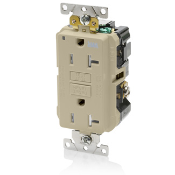555.35 GFPE and GFCI Protection in Marinas, Boatyards, Floating Buildings, and Commercial and Noncommercial Docking Facilities
Change Summary
- Ground-Fault Protection of Equipment (GFPE) and Ground-Fault Circuit-Interrupter (GFCI) Protection:
GFP protection divided into three parts:
555.35(A) addresses shore power receptacles (not to exceed 30 mA),
555.35(B) addresses 15- and 20 ampere receptacles for other than shore power [GFCI protection (4 to 6 mA)], and
555.35(C) addresses feeder and branch circuit conductors that are installed on docking facilities (not to exceed 100 mA). Language added to require leakage current measurement devices.
| NEC® Text |
|---|
|
555.35 Ground-Fault Protection of Equipment Material taken from the National Electric Code® is reprinted with permission from NFPA 70®, 2020 edition. |
Expert Analysis
For the 2020 NEC, the ground-fault protection (GFP) requirements of marinas, boatyards, and docking facilities was extensively revised. These GFP requirements (previously located at 555.3) were divided into three parts to provide clarity for these important ground-fault requirements. Section 555.35(A)(1) addresses shore power receptacles with individual GFPE not to exceed 30 milliamperes (mA). Section 555.35(A) (2) addresses 15- and 20-ampere receptacles for other than shore power with Class A GFCI protection (4 to 6 mA) being provided in accordance with 210.8 through a reference to 555.33(B)(1). Section 555.35(A)(3) will address feeder and branch circuit conductors providing power to a slip and installed on docking facilities to be provided with GFPE set to open at currents not exceeding 100 mA with coordination with downstream GFPE permitted at the feeder overcurrent protective device.

An exception was added which would exempt transformer secondary conductors of a separately derived system [not exceed 3 m (10 ft] installed in a raceway from this GFPE protection as it would be difficult to provide ground-fault protection on the conductors from the transformer to the first panelboard where the transformer resides on the docking facility. It was noted in the substantiation that 50 percent of the electric shock drownings (ESD) incidents could be avoided by the 30 mA protection at the shore power receptacles whereas the existing overall 30 mA ground-fault protection for the entire marina was too low for most marinas. Informational notes were also added to address the concerns regarding vessel testing to alleviate potential leakage current that contributes to ESD as test data has shown that a great deal of the stray current in the water around marinas comes from the boats (vessels) themselves. While the NEC rules cannot demand that the vessels be tested for current leakage, language will be put in place to require leakage current measurement devices to be in place and available at marinas and boatyards where more than three receptacles supply shore power to boats.
Leviton Solution
Marine environments can be hard on all electrical equipment, wiring devices are no exception. The Leviton line of Extra-Heavy Duty Weather and Tamper-Resistant GFCI receptacles exceed all standards pertaining to GFCI devices, truly making Leviton the smart choice when it comes to personnel protection. Designed with the installer in mind, the devices include features that reduce the chance of miswire and provide dependable and secure connections. GFCIs installed outdoors should be protected by an appropriate weather-proof cover.









